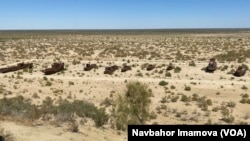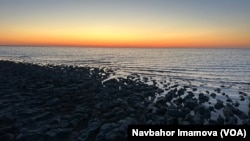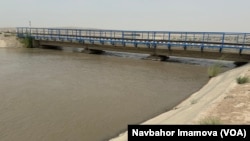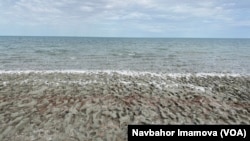The Amu Darya, one of two main rivers that for millennia fed the now rapidly shrinking Aral Sea, no longer does.
Reporting by VOA along the length of the river in Uzbekistan has confirmed that every drop of water from the Amu Darya — formed by the convergence of the Vakhsh and Panj rivers in the mountains between Afghanistan and Tajikistan — is now diverted for human use.
“The Amu Darya is now fully utilized for agriculture and other economic needs,” said Rustam Saparbayev, deputy chairman of the parliament of Karakalpakstan, Uzbekistan’s northwestern part, where the river ends its journey to nowhere.
Saparbayev told VOA that all the river’s water is directed into five canals in southern Karakalpakstan, lamenting that there isn’t enough water for both the sea and the population.
“This is the hardest decision for us. Our priority is the immediate needs of our people. We rely on the Amu Darya to grow our crops and livestock. Water is extremely scarce in this environment, and we must prioritize food and water security,” he emphasized.
In a region already strapped for water, Karakalpakstan faces the most severe environmental challenges and the devastating impact of climate change. The Aral Sea, located largely within its territory, has dramatically shrunk over the past few decades.
Over 30,000 people live in Muynak, which was once a bustling Aral Sea port with a thriving fishing industry, but it now lies a dusty several-hour drive from the water. Since the 1970s, many residents have left because of the environmental disaster.
Nevertheless, VOA noted significant construction and business growth in the area, which the central government in Tashkent cites as evidence of increased investment in the region.
“The conditions here have improved,” said Murod Jumaboyev, Muynak’s deputy mayor. “We have been adapting to the climate challenges.
“We still face enormous difficulties with the sea essentially deserted, but we are trying to preserve what remains. With help from our government and the international community, we are revitalizing the area, hoping to turn it into sustainable groves, adopt alternative crops and create a new ecosystem — both environmental and economic,” Jumaboyev said.
There is a local “artemia season,” during which aquatic crustaceans living in the extremely salty waters of what remains of the Aral Sea are harvested for pharmaceutical use. Locals skilled at collecting them sell them to Chinese firms for several hundred dollars per pack.
Muynak residents told VOA that their situation has slightly improved but said they rely heavily on remittances from relatives working abroad.
“We are the people of the Aral Sea. The sea may have largely left us, but this is still our land. It may be harder here, but I know it’s not easy anywhere,” said Maksudbek, who works for a travel firm but declined to give his last name.
According to Muynak officials, more than 20,000 tourists visited last year, marking a significant increase over previous years.
What used to be the shores and shipyards of the Aral Sea are now more than 200 kilometers from the remaining water. It took VOA about four hours in a special jeep to reach the sea.
No population inhabits the area — it is too dry and salty even for most wildlife. A couple of campsites, powered by solar energy, have been built in recent years.
Workers there told VOA that the water receded by about 50 meters over the past year. Very few tourists make it to the sea; most only tour the former Muynak port, particularly the “graveyard of ships,” where rusting vessels sit on a desert landscape.
The Aral Sea appears passive and eerily calm at night. No fish are left, with only a few birds, visible mainly at sunrise and sunset. The gray mud is thought to have therapeutic properties, but the sea’s remoteness makes it difficult to access.
Kazakhstan has succeeded in reviving parts of the sea’s northern shores, but from the perspective of the Karakalpaks, who oversee most of it, the Aral Sea is rapidly vanishing.
“We can still save the Aral Sea, but it will require a global effort. No matter what we hear from the U.N. and other organizations, and despite current assistance, there won’t be significant change without concrete action,” said Saparbayev.
“There are international missions to save exotic animals and historic sites. The Aral Sea needs similar attention. In our view, the solution is bringing water — but from outside our region, as it can no longer come from the Amu Darya,” he said.
Further upstream, water from the Amu Darya is drawn off for use in the Bukhara, Khorezm and Surkhandarya regions, which have a combined population of 9 million. Farmers and officials there told VOA that water availability currently meets their basic needs.
But Afghanistan’s construction of a canal off the Amu Darya is cause for concern. Local leaders hope that the governments of Uzbekistan, Tajikistan and Turkmenistan can persuade the Taliban to join a water-sharing agreement, something a regional working group is expected to draft.
“We trust that our government is doing everything possible,” said Umid Akhmedov, Surkhandarya’s lead specialist on water resources. “We haven’t felt the impact of the Afghan canal yet, but if and when it draws more water, we will have to adapt. We are already implementing new water-use and preservation methods.”
The Amu Zang canal is the first channel formed as the Amu Darya enters Uzbekistan. Speaking to VOA from this area, Akhmedov explained that Surkhandarya depends on this water.
“We don’t use it for drinking since it’s very muddy, but for everything else, it’s a critical resource.”
In Khorezm, with its desert climate, summers are cooler along the Amu Darya and traditional tea houses and restaurants — sometimes on boats — are popular, particularly around the regional capital, Urgench, and the historic city of Khiva.
VOA saw a similar scene in Karakalpakstan, specifically in Amu Darya District, where a new bridge over the river has eased transit and expanded business opportunities.
However, fishermen told VOA that fish are now scarce in the river, with most of what is sold as “Amu fish” coming from the farms drawing water from the river.
Scarcity, extreme depletion, and decline — these words dominate every conversation about water in Uzbekistan, reflecting a challenging reality and growing concern about the future. People blame Soviet-era irrigation and emphasize the need for regional cooperation to produce solutions.
“We are doing our part by using the water for our most critical needs. The Amu Darya still reaches us, but it no longer feeds the Aral Sea. We hope the world will help us save it,” said Saparbayev.
In addition to the Surkhandarya region, reporting for this story also took place in Khorezm and Karakalpakstan, Uzbekistan. This report originated from VOA’s Uzbek Service.






